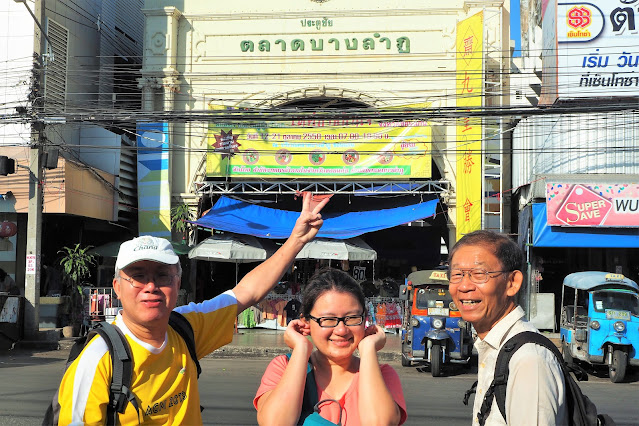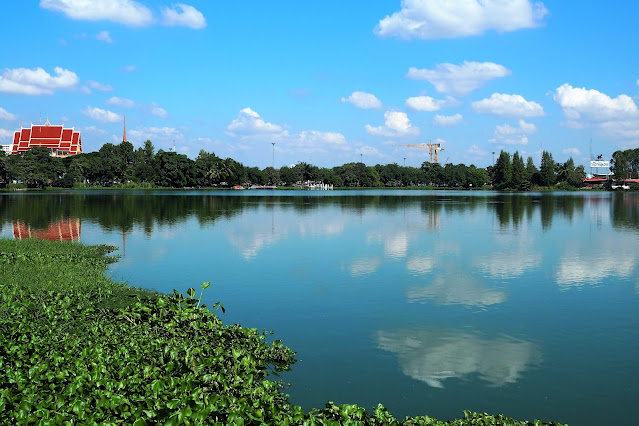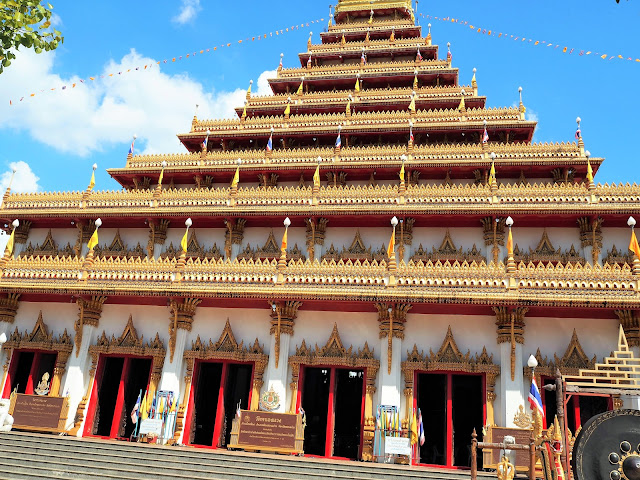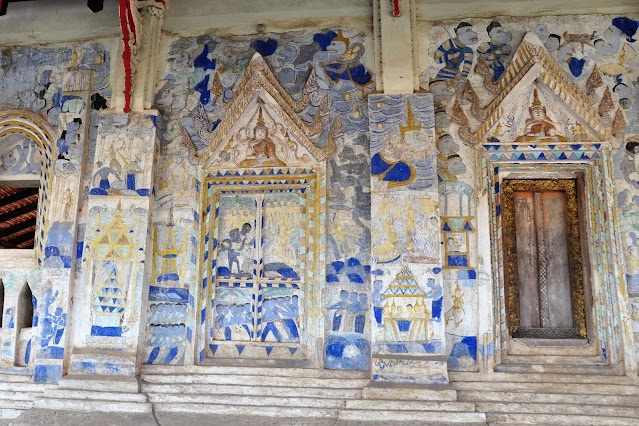North-Eastern (I-San) Thailand and Laos, 16 Nov - 10 Dec 2015 (25days) 
L-R: Chew Leng Soon, Chia Chai Ling, Ching Neng Bin, Chan Meng Fye at Ban Sawathi, Wat Chai Sri.
Day 3 (18.11.2015) Khon Kaen City walk around
Khon Kaen is the capital of northeastern Thailand and is rarely visited by backpackers. It's a lively and vibrant city with lots of nightlife, delicious I-san food, and friendly people. In the morning we walked down the main street of Klang Muang to the market and had breakfast.
We visited Wat Phra That and Wat Klang Muang Kao. We then walked along Kaen Nakorn Lake to visit Chao Por Mahesak Temple and Wat Nong Waeng Muang Kao.
In the afternoon we took a tuk tuk to the City Shrine and the city gates. Then, in a taxi, we visited an old temple built in 1865 at Ban Sawathi, Wat Chai Sri. Our dinner was on Ruenrom Road for street food.
Sleeping: Rome Hotel in Khon Kaen.
Khon Kaen is the commercial administrative and educational center of the Northeast, which is often used by travelers as a base for visiting many parts of upper I-san region.
Khon Kaen's Post Office with the gigantic letter box.
The roadside tailors in Khon Kaen.
At the entrance of the Khon Kaen morning market.
At the Khon Kaen morning market.
We do not know what is this eaten as vegetables at the Khon Kaen morning market.
For our breakfast at the Khon Kaen morning market.
Our breakfast at the Khon Kaen morning market.
On the street at Khon Kaen.
Khon Kaen municipal fresh food market.
Statue and decorative city lamp post of Ruenrom Road, Khon Kaen.
Fairy Plaza in Khon Kaen.
Wat Phra That - The first governor of Khon Kaen, Phraya Nakhon Sri Borirak Raja Bhakdi, built this Wat Phra That temple, on the northern side of the lake, in 1789, around the time the city was founded. The name of the temple was derived from the Phra That pagoda, built as a holy site for the locals to worship. Many of the pagodas on the temple ground are badly ruined and it's no longer possible to identify which one is the original. The temple lcommittee decided to build a new pagoda which soars over the old ruins to a height of 45 metres.
Wat Phra That is probably the most photographed temple of Khon Kaen city since it sits picturesquely at the lake in front of the skyline of the city. The temple was built in 1789.
Wat Phra That, Khon Kaen contains a beautiful Lan Chang-style Buddha image called Luang Phor Phra Lub. 
This is how to take good wide angle picture by getting down on your knees. Photo taken by Chew Leng Soon.

Notice the pig behind Ching Neng Bin in Wat Phra That. In the Buddhist teachings, the three poisons (of ignorance, attachment, and aversion) are the primary causes that keep sentient beings trapped in samsara. Saṃsāra (Sanskrit) is the repeating cycle of birth, life and death (reincarnation) as well as one's actions and consequences in the past, present, and future.
The three poisons are represented in the hub of the wheel of life as a pig, a bird, and a snake (representing ignorance, attachment, and aversion, respectively). As shown in the wheel of life (Sanskrit: bhavacakra), the three poisons lead to the creation of karma, which leads to rebirth in the six realms of samsara. Of these three, ignorance is the root poison. From ignorance, attachment and aversion arise.
The giant gong at Wat Phra That, Khon Kaen.
The gigantic fishing basket at Wat Phra That, Khon Kaen.
Wat Phra That, Khon Kaen.
Mahachulalongkornrajavidyalaya University, Khon Kaen Campus.
Wat Klang Muang Kao in Khon Kaen.
Wat Klang Muang Kao in Khon Kaen.
Wat Klang Muang Kao in Khon Kaen.
Ching Neng Bin the pigeon man in Khon Kaen.
Ching Neng Bin the pigeon man in Khon Kaen. 
Ching Neng Bin the pigeon man in Khon Kaen. 
A walk in the Kaen Nakhon Lake park in Khon Kaen.
Kaen Nakhon Lake is located southeast of Khon Kaen centre. The lake is one of the main features in Khon Kaen. The length around the lake is approximately 4km long. It is a good place to bring kids. You can hire a bicycle to ride with family and friends, or enjoy a walk in the park or just to let your kids play in the playground.
Kaen Nakorn Lake in Khon Kaen. 
Kaen Nakorn Lake in Khon Kaen.
Chao Por Mahe Sak Shrine in Khon Kaen.
Elephants statue at Chao Por Mahe Sak Shrine, Khon Kaen
The huts at Chao Por Mahe Sak Shrine, Khon Kaen.
The deity of Chao Por Mahe Sak Shrine, Khon Kaen.
Wat Nong Waeng Muang Kao, Khon Kaen. The temple grounds open daily from 7am until 5pm. Admission is free. Please dress respectfully, meaning no revealing clothes.
Wat Nong Waeng Muang Kao. Located in this royal temple on Klang Mueang Road, is the Phra Mahathat which houses relics of the Lord Buddha and important Buddhist scriptures. Doors and windows of the 9 storeys of the stupa are beautifully carved, featuring the life and former reincarnations of the Lord Buddha, 16 classes of visible deities in the Brahma’s world, and Buddhist rites. Murals within the stupa feature history of the town. The top floor, on the 9th storey, houses relics of the Lord Buddha.
Wat Nong Waeng Muang Kao. On the stairs towards the temple extend the bodies of multi headed Nagas, a snake from Buddhist mythology. On the large temple grounds of 4½ acres surrounding the chedi are various symbols and images such as a Dhamma wheel with two elephants, Naga snakes and Buddha images.
Wat Nong Waeng Muang Kao. At the center of the first floor is a very ornate throne that enshrines relics where Buddhists come to pray and make merit. Along the walls are several large images of the Buddha in the Phra Buddha Chinnarat style, statues of important monks as well as a long row of alms bowls, in which devotees put coins to make merit. Over the windows are large colorful murals.
The 4th floor contains a collection of old Buddha images. On the 8th floor visitors can see a collection of scriptures from the Tripitaka, the Buddhist teachings. The 9th floor enshrines relics of the Buddha. Other stories contain displays of ancient objects, a learning hall for monks, a collection of Buddha images and Buddhist artifacts, several historical displays and fortune telling machines. Murals depict the history of Khon Kaen, daily life of Isan people and their culture as well as Buddhist stories. The wooden doors and window panels are carved with stories from the Jataka tales, the stories that tell about the previous lives of the Buddha.
Wat Nong Waeng Muang Kao in Khon Kaen.
The sacred City Shrine of Khon Kaen.
The sacred City Shrine is on Thepharak Road in the compound of the Khon Kaen Municipality Office. A famous monk and former governor of Khon Kaen placed a stone inscription from an ancient site in Amphoe Chum Phae here for a Buddhism rite and set up the city pillar shrine. 
The sacred City Shrine of Khon Kaen. 
The dragon pillar at the sacred City Shrine of Khon Kaen.
Khon Kaen City Gate located beside Central Plaza shopping complex. From here we took a taxi to Wat Chai Sri which was 20km away.
Wat Chai Sri at Ban Sawathi, is 20km away from Khon Kaen city.
The 1865 Wat Chai Sri at Ban Sawathi, Khon Kaen is a beloved attraction in Thailand’s Isaan province, because of its unique murals depicting the ancient Sin Sai story. Sin Sai is a valuable literature of the former Lan Chang people. From 1354 to 1707, the Lao kingdom of Lan Chang was one of the largest in Southeast Asia… they even ruled here in Isan.
Wat Chai Sri at Ban Sawathi, Khon Kaen is an ancient temple with I-san architectural style Sim or main chapel. Its interior & outer walls have murals illustrating local cultures.
The main entrance of Wat Chai Sri at Ban Sawathi, Khon Kaen.
The main entrance of Wat Chai Sri at Ban Sawathi, Khon Kaen.
The main door of Wat Chai Sri at Ban Sawathi, Khon Kaen.
The intricately carved door of Wat Chai Sri in Ban Sawathi, Khon Kaen.
Interior walls of Wat Chai Sri in Ban Sawathi, Khon Kaen have murals depicting local culture.
Interior walls of Wat Chai Sri in Ban Sawathi, Khon Kaen have murals depicting local culture.
Interior walls of Wat Chai Sri in Ban Sawathi, Khon Kaen have murals depicting local culture.
Interior walls of Wat Chai Sri in Ban Sawathi, Khon Kaen have murals depicting local culture.
Outer walls of Wat Chai Sri in Ban Sawathi, Khon Kaen have murals depicting local culture.
Outer walls of Wat Chai Sri in Ban Sawathi, Khon Kaen have murals depicting local culture.
Outer walls of Wat Chai Sri in Ban Sawathi, Khon Kaen have murals depicting local culture.
Outer walls of Wat Chai Sri in Ban Sawathi, Khon Kaen have murals depicting local culture.
Outer walls of Wat Chai Sri in Ban Sawathi, Khon Kaen have murals depicting local culture.
Outer walls of Wat Chai Sri in Ban Sawathi, Khon Kaen have murals depicting local culture.
L-R: Chew Leng Soon, Chia Chai Ling, Ching Neng Bin, Chan Meng Fye at Ban Sawathi, Wat Chai Sri.
The monks' kuti at Ban Sawathi, Wat Chai Sri.
The Khon Kaen Night Market is held on Ruenrom Road every night from 17:00 to midnight.
The Khon Kaen Night Market is held on Ruenrom Road every night from 17:00 to midnight.
It's a good place to buy and eat cheap local food at Khon Kaen Night Market. Everything is written in Thai and although few vendors speak English, we were able to order our food with gestures.
It's a good place to buy and eat cheap local food at Khon Kaen Night Market.
It's a good place to buy and eat cheap local food at Khon Kaen Night Market.
| Day 3 | Cost Item in Thai Baht | Bus/car | Food | Hotel | Fee | Total | per pax |
| Khon Kaen | Breakfast | 150 | 150 | 38 | |||
| Roma Hotel | Hotel Roma room1 | 500 | 500 | 250 | |||
| Hotel Roma room2 | 650 | 650 | 325 | ||||
| Water | 50 | 50 | 13 | ||||
| Lunch | 160 | 160 | 40 | ||||
| Song taew in town | 36 | 36 | 9 | ||||
| Song taew in town | 36 | 36 | 9 | ||||
| Song taew in town | 36 | 36 | 9 | ||||
| 7-11 Water | 41 | 41 | 10 | ||||
| Return taxi to Wat Chai Si | 450 | 450 | 113 | ||||
| Supermarket snacks | 96 | 96 | 24 | ||||
| Dinner at Night Market | 358 | 358 | 90 |
North-Eastern Thailand and Laos - Introduction
Day 01 (16.11.15) AirAsia AK 856 KUL. 12.45pm to Chiang Mai, (1738km)
Day 02 (17 Nov) Chiang Mai to Loei to Phu Kradueng to Khon Kaen (691km)
Day 03 (18 Nov) Khon Kaen City walk around
Day 04 (19 Nov) Khon Kaen City to Kalasin (80km)
Day 05 (20 Nov) Kalasin to Sakon Nakhon (129km)
Day 06 (21 Nov) Sakon Nakhon to Nakhon Phanom (92km)
Day 07 (22 Nov) Nakhon Phanom - day trip to Thakhek, Laos (62km)
Day 08 (23 Nov) Nakhon Phanom to Mukdahan (125km)
Day 09 (24 Nov) Mukdahan - trip to Phu Pha Thoet National Park (108km)
Day 10 (25 Nov) Mukdahan to Ubon Ratchathani by bus (194km)
Day 11 (26 Nov) Ubon Ratchathani to Pakse to Si Phan Don, Laos (291km)
Day 12 (27 Nov) Si Phan Don - a long walk to Somphamit Waterfall
Day 13 (28 Nov) Si Phan Don to Ubon Ratchathani by bus (291km)
Day 14 (29 Nov) Ubon Ratchathani to Si Sa Ket by van (67km)
Day 15 (30 Nov) Si Sa Ket to Buri Ram by train (148km)
Day 16 (01 Dec) Buri Ram - day visit to 3 places (219km)
Day 17 (02 Dec) Buri Ram to Nakhon Ratchasima by train (129km)
Day 18 (03 Dec) Nakhon Ratchasima - day trip to Phimai (120km)
Day 19 (04 Dec) Nakhon Ratchasima to Bangkok by train (264km)
Day 20 (05 Dec) Bangkok - Chao Phraya River boat ride to Khaosan Road
Day 21 (06 Dec) Bangkok - rest day and dinner at Royal Bangkok Sports Club
Day 22 (07 Dec) Bangkok to Prachuap Khiri Khan by train (320km)
Day 23 (08 Dec) Prachuap Khiri Khan
Day 24 (09 Dec) Prachuap Khiri Khan to Hatyai by night train (660km)
Day 25 (10 Dec) Hatyai to Butterworth by train and to KL by bus (555km)



























































